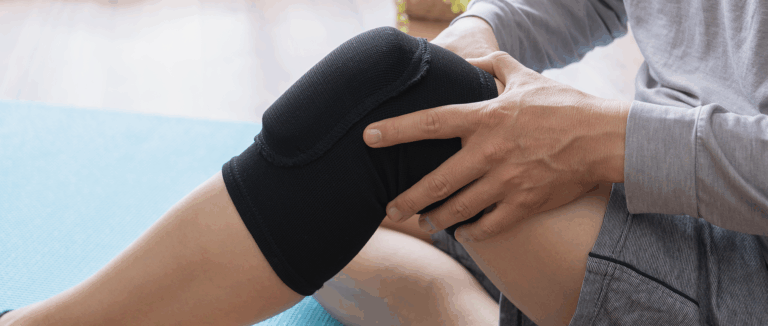Complementary Medicine for Pain and Inflammation Related Conditions
Summary
Millions of people in the U.S. are affected by chronic pain, which is associated with different health conditions from cancer to autoimmune disease.
Chronic pain affects more than 3 million people in the United States each year and is defined as “persistent pain that lasts weeks to years.” Chronic pain is associated with many conditions, ranging from psychological factors to autoimmune conditions to cancer: so many conditions, in fact, that the American Chronic Pain Association has an A to Z list of them. Women tend to suffer from pain and chronic pain conditions at a higher rate than men, and the American Society of Addiction Medicine reports that “women may become dependent on prescription pain relievers more quickly than men” do.1
As the prevalence of pain and chronic pain conditions continues to rise, so has the use and misuse of opioid painkillers by patients to manage their pain conditions. According to a 2016 report from the Surgeon General of the United States, over 28,000 people died in 2014 from a drug overdose involving some type of opioid.2 The Centers for Disease Control and Prevention (CDC) reported that that figure climbed to over 33,000 in 2015, and continues to rise.3
While chronic pain cannot be cured, treatments like acupuncture, cognitive behavioral therapy, and other complementary medicine strategies can help to reduce the frequency and severity of symptoms. Many patients who seek out complementary or integrative therapies suffer from chronic pain and are motivated by their pain conditions to seek alternative therapies beyond conventional opioid prescriptions. Because pain is often associated with inflammation, a condition in and of itself that is associated with a variety of poor health outcomes, managing inflammation and pain through complementary therapies or nutrition therapy can be a safer and more effective alternative to prescription painkillers.
How Inflammation Causes Pain
In broad terms, inflammation occurs when the body’s immune system is responding to some stimulus such as a wound, pathogen, or other infection. It involves the body’s detection of “noxious stimuli,” transmission of the information to the brain, and the subsequent reaction by the immune system, and by the affected individual.4
In cases of acute inflammation, immune cells release inflammatory mediators, which cause blood vessels to dilate. The dilated blood vessels bring more blood, fluids, and immune mediating substances, known as cytokines, to the affected area. The additional blood and fluids in the affected area can cause redness, heat, swelling, and pain. Eventually, the immune system works to heal the injury or eliminate the infection and inflammation resolves. The immune system in chronic pain conditions is similar and involves a more complex sequence of cytokines, pain receptors, and mediators. Some important markers of inflammation that can also be associated with pain conditions include interleukin-6 and C-reactive protein. In cases of chronic inflammation, complete resolution of inflammation does not occur, so the process and experience of pain is continual.
Acupuncture, Chiropractic Care, and Nutrition Therapy for Pain and Chronic Pain Conditions
Acupuncture for Chronic Pain
Acupuncture is widely used for chronic pain conditions and is a safe alternative to invasive procedures or pharmacological therapies. A 2012 systematic review pooled data from nearly 18,000 patients who sought acupuncture treatment for four chronic pain conditions, including back and neck pain, osteoarthritis, chronic headache, and shoulder pain. 29 of 31 eligible trials were included in the analysis, which found similar effect sizes across each of the studies.5
In each study, acupuncture was compared to both sham acupuncture and no treatment. Patients who underwent acupuncture treatment had less pain than those who underwent sham acupuncture and those who had no treatment. The difference in pain scores ranged from 0.15 to 0.23 standard deviations lower when comparing acupuncture to sham acupuncture, and ranged from 0.42 to 0.57 standard deviations lower when comparing acupuncture to no treatment. Unlike many meta-analyses and studies in the area of complementary medicine, this meta-analysis includes high-quality data, a large sample size, and little publication bias.5
A Harvard Health article describing the findings of the meta-analysis explains that, “the effect of acupuncture is to adjust our body’s neurotransmitters, hormone levels, or immune system,” some of the factors closely related to inflammation and pain. The study’s authors also suggest that there is more to acupuncture beyond the effects of needle insertion that make the procedure effective and therapeutic, such as the personalized therapy and one-on-one attention.6
Chiropractic Care for Chronic Pain
Chiropractic care can also play a role in managing chronic pain. A randomized controlled trial published in 2003 in the British Medical Journal evaluated and compared the effectiveness and costliness of spinal mobilization, physical therapy, or general treatment (counseling, education, and drugs) on chronic neck pain over the course of one year.7 Researchers evaluated patients on their perceived recovery, intensity of pain, functional disability, and utility after treatment.
The 183 patients were randomized to one of the three treatment branches and the group that received spinal manipulation treatment demonstrated the best results at each of the measurement points throughout the yearlong study. Indeed, in as few as seven weeks, 68 percent of those patients in the spinal manipulation group made a complete recovery, compared to 51 percent of the patients in the physical therapy group and 36 percent in the general care group. As a bonus, the total costs of the spinal manipulation group were about one-third of the costs of the other two groups.7
While this comparative study was long in duration, it also showed the speed at which spinal manipulation therapy can “kick in” and lead to a full recovery of patients with neck pain. Another shorter-term study may also shed some light on a possible mechanism of chiropractic care on pain treatment: inflammation resolution. The study randomized 21 patients either to lumbar spinal manipulation or to a control group that received no treatment. Researchers measured the inflammatory markers interleukin-6 and C-reactive protein in the patients’ blood before and after nine chiropractic sessions over two weeks consisting of lower back manipulations.8
While there were significant differences in inflammatory markers between the two groups before the intervention and the effect size is relatively small, the inflammatory mediators did respond to the course of chiropractic treatment. Both C-reactive protein and interleukin-6 levels were attenuated after chiropractic treatment.8 This result is also supported by a literature review on the relationship between spinal manipulation and another pro-inflammatory mediator, tumor necrosis factor (TNF). The review found evidence that suggests that there may be an interaction between TNF and immune T cells, which further suggests that spinal manipulation can influence inflammation and immuno-resolution.9
Nutrition Therapy for Pain Management
Complex chronic pain conditions like chronic oro-facial pain bring nutrition status to the forefront. While chronic pain of the mouth and face can make it difficult to consume a nutritious diet, nutritional status may also play a role in the inflammatory pathophysiology of chronic oro-facial pain. A 2014 literature review suggests that antioxidant status may play a role in determining oro-facial pain status and pathophysiology.10 Beyond antioxidants, the fatty acid profile of a diet may also play a role in inflammation and pain. Specifically, omega-3 fatty acids dampen inflammation, but the specific impact on oro-facial pain is unknown.
Policymaking and professional groups are also pursuing research and implementation of nutrition therapy for pain conditions. For example, the Italian Ministry of Instruction sponsored an event entitled “Nutraceuticals and Innovative Pharmacology” in 2016. The chief recommendations from the symposium were for clinicians to perform nutrition assessments for patients with chronic pain conditions and that there are “formidable and highly promising” benefits associated with including nutrition in personalizing pain medicine.11
Obstacles and Attitudes Toward Complementary Care for Pain Management
In 2016, a qualitative study of 90 patients who had chronic musculoskeletal pain was completed with the objective of identifying issues and challenges associated with seeking pain therapies other than opioids. Primary care providers, acupuncturists, and chiropractors were also interviewed about their experiences managing chronic pain with their patients and clients. Through focus groups and structured interviews, the researchers found that both patients and practitioners are dissatisfied with opioid medications, but that there are practical barriers associated with seeking acupuncture or chiropractic care, including timing, expectations of effectiveness, and insurance plan coverage of the treatments.12 A 2017 survey of patients with chronic low back pain found that oral drugs are perceived to be the most effective therapy, though complementary therapies followed in second place. Happily, though, 58% of chronic pain patients recently surveyed indicated that they had used acupuncture or chiropractic therapies.13
While patients may view pharmacological and non-pharmacological therapies as most effective, lifestyle change, including reducing or stopping smoking and alcohol consumption, eating a more healthful diet, and increasing physical activity led to superior long-term pain alleviation. Whether alternative therapies can replace opioid medications for pain treatment remains to be seen, but managing inflammation, pain, and chronic pain conditions through acupuncture, chiropractic care, and nutrition therapy offer strong alternatives with very few associated risks.
- American Society of Addiction Medicine. (2016). Opioid addiction 2016 facts and figures. Retrieved from, https://www.asam.org/docs/default-source/advocacy/opioid-addiction-disease-facts-figures.pdf
- US Department of Health and Human Services. (2016, November). Facing addiction in America: the surgeon general’s report on alcohol, drugs, and health. Retrieved from, https://templatearchive.com/facing-addiction-in-america/
- Rudd, RA., Seth, P., David, F., Scholl, L. (2016). Increases in drug and opioid-involved overdose deaths — United States, 2010–2015. MMWR Morb Mortal Wkly Rep; 65:1445–1452. DOI: http://dx.doi.org/10.15585/mmwr.mm655051e1external icon.
- Kidd, BL., Urban, LA. (2001, June, 1). Mechanisms of inflammatory pain. British Journal of Anaesthesia; 87(1) 3-11. https://doi.org/10.1093/bja/87.1.3
- Vickers, AJ., Cronin, AM., Maschino, AC., et al. (2012). Acupuncture for chronic pain: individual patient data meta-analysis. Arch Intern Med;172(19):1444-1453.
- Harvard Men’s Health Watch. (2013, April). Is acupuncture for you? Retrieved from, https://www.health.harvard.edu/pain/is-acupuncture-for-you
- Korthals-de Bos, I. B., Hoving, J. L., van Tulder, M. W., Rutten-van Mölken, M. P., Adèr, H. J., de Vet, H. C., Koes, B. W., Vondeling, H., & Bouter, L. M. (2003). Cost effectiveness of physiotherapy, manual therapy, and general practitioner care for neck pain: economic evaluation alongside a randomised controlled trial. BMJ (Clinical research ed.), 326(7395), 911. https://doi.org/10.1136/bmj.326.7395.911
- Roy, R. A., Boucher, J. P., & Comtois, A. S. (2010). Inflammatory response following a short-term course of chiropractic treatment in subjects with and without chronic low back pain. Journal of chiropractic medicine, 9(3), 107–114. https://doi.org/10.1016/j.jcm.2010.06.002
- Zhang, L., & Yao, C. H. (2016). The Physiological Role of Tumor Necrosis Factor in Human Immunity and Its Potential Implications in Spinal Manipulative Therapy: A Narrative Literature Review. Journal of chiropractic medicine, 15(3), 190–196. https://doi.org/10.1016/j.jcm.2016.04.016
- Durham, J., Touger-Decker, R., Nixdorf, DR., Rigassio-Radler, D., Moynihan, P. (2014, September 9). Oro-facial pain and nutrition: a forgotten relationship? Journal of Oral Rehabilitation; 42 (1). https://doi.org/10.1111/joor.12226
- De Gregori, M., Muscoli, C., Schatman, M. E., Stallone, T., Intelligente, F., Rondanelli, M., Franceschi, F., Arranz, L. I., Lorente-Cebrián, S., Salamone, M., Ilari, S., Belfer, I., & Allegri, M. (2016). Combining pain therapy with lifestyle: the role of personalized nutrition and nutritional supplements according to the SIMPAR Feed Your Destiny approach. Journal of pain research, 9, 1179–1189. https://doi.org/10.2147/JPR.S115068
- Penney, L. S., Ritenbaugh, C., DeBar, L. L., Elder, C., & Deyo, R. A. (2017). Provider and patient perspectives on opioids and alternative treatments for managing chronic pain: a qualitative study. BMC family practice, 17(1), 164. https://doi.org/10.1186/s12875-016-0566-0
- Ondrejkovicova, A., Petrovics, G., Svitkova, K., & Balogh, V. (2017). Is non-pharmacological treatment an effective option for chronic low back pain?. Neuro endocrinology letters, 38(3), 169–172.







